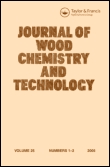
JOURNAL OF WOOD CHEMISTRY AND TECHNOLOGY
Scope & Guideline
Bridging Theory and Practice in Wood Chemistry
Introduction
Aims and Scopes
- Wood Chemistry and Biochemistry:
The journal extensively covers the chemical composition and biochemical properties of wood, including lignin, cellulose, and hemicellulose, and their transformations. This includes studies on the mechanisms of lignin degradation and the chemical processes involved in wood treatment. - Wood Modification and Functionalization:
Research on the modification of wood to enhance its properties, such as durability, hydrophobicity, and mechanical strength, is a core focus. This includes chemical treatments, surface modifications, and the development of composite materials. - Sustainable Utilization and Biorefinery Concepts:
The journal promotes studies on the sustainable use of wood resources and the development of biorefinery processes that convert wood biomass into valuable products. This includes research on waste valorization and eco-friendly extraction methods. - Nanotechnology and Advanced Materials:
There is a growing emphasis on the application of nanotechnology in wood science, particularly in the preparation of nanocellulose and other nanomaterials derived from wood, which have potential applications in various fields. - Environmental Impact and Wood Preservation:
Research addressing the environmental impact of wood utilization and the development of eco-friendly wood preservatives is also significant. This includes studies on biodeterioration prevention and assessment of natural durability.
Trending and Emerging
- Green Chemistry and Sustainable Practices:
A significant trend is the emphasis on green chemistry principles, focusing on eco-friendly processes and materials that minimize environmental impact. This includes the use of renewable solvents and sustainable extraction methods. - Advanced Characterization Techniques:
There is a growing trend towards the use of sophisticated characterization techniques, such as NMR and spectroscopy, to analyze wood components and their interactions, providing deeper insights into wood chemistry. - Functional Materials from Wood Biomass:
Research into developing functional materials, such as hydrogels and composites with specific properties derived from wood biomass, is increasingly prominent. This includes applications in pharmaceuticals, packaging, and environmental remediation. - Bioactive Compounds and Health Applications:
The exploration of bioactive compounds derived from wood and their potential health benefits is emerging as a noteworthy theme, linking wood science with pharmacology and nutrition. - Nanomaterials and Their Applications:
The incorporation of nanotechnology in wood chemistry, particularly in the development of nanocellulose and other nanomaterials for various applications, is gaining traction and represents a cutting-edge area of research.
Declining or Waning
- Traditional Wood Processing Techniques:
Research focusing solely on conventional wood processing methods has declined, likely due to the rising interest in advanced and sustainable techniques that offer better efficiency and environmental benefits. - Basic Wood Anatomy and Structure Studies:
While foundational studies in wood anatomy are essential, there has been a noticeable decrease in publications solely dedicated to basic anatomical studies, as the field has advanced towards more applied research with practical applications. - Non-renewable Chemical Treatments:
There is a waning interest in studies centered around non-renewable chemical treatments for wood preservation, as the focus shifts towards more sustainable and biodegradable alternatives.
Similar Journals
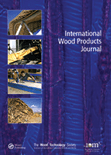
International Wood Products Journal
Elevating the Discourse on Wood ProductsInternational Wood Products Journal is a premier academic publication dedicated to advancing knowledge in the fields of forestry and materials science. Published by SAGE Publications Inc, this journal serves as a critical forum for researchers and professionals alike, focusing on innovative developments and sustainable practices related to wood and wood products. With an impressive impact factor that places it in the Q2 category for forestry and Q3 for materials science in 2023, it showcases high-quality research that influences policy and practice. Covering a wide scope from 2010 to 2024, the journal offers insightful articles and reviews that highlight the latest findings and technological advancements in wood products. Notably indexed in Scopus, it ranks 69th out of 174 in Forestry and 296th out of 463 in General Materials Science, attesting to its relevance and contribution to these fields. Researchers and students are encouraged to explore this journal for cutting-edge information and collaborative opportunities within the international wood products community.

CELLULOSE CHEMISTRY AND TECHNOLOGY
Pioneering Research in Green MaterialsCELLULOSE CHEMISTRY AND TECHNOLOGY, published by EDITURA ACAD ROMANE, is a pivotal journal in the fields of materials and organic chemistry. With a unique focus on cellulose and its derivatives, this journal explores innovative research and developments that contribute to sustainable materials science. Established in 1972, it boasts a rich history of publication, aligning closely with advances in green chemistry and bio-based materials. Recognized with a Q3 ranking in both Materials Chemistry and Organic Chemistry, the journal provides a platform for researchers to disseminate valuable findings that push the boundaries of cellulose applications. Despite its non-open-access status, it remains an essential resource for academics and professionals seeking authoritative content in cellulose science. With relevant insights into the changing dynamics of materials research, CELLULOSE CHEMISTRY AND TECHNOLOGY serves as a critical link for ongoing discussions in the scientific community, proposing solutions and exploring new avenues for cellulose utilization.

University Politehnica of Bucharest Scientific Bulletin Series B-Chemistry and Materials Science
Pioneering Research for Tomorrow's ChallengesUniversity Politehnica of Bucharest Scientific Bulletin Series B-Chemistry and Materials Science is a renowned academic journal published by POLYTECHNIC UNIV BUCHAREST, situated in Romania. With the ISSN 1454-2331, this journal serves as a dynamic platform for the dissemination of innovative research findings in the fields of chemistry and materials science. Although classified in the Q4 quartile of both Chemistry (miscellaneous) and Materials Science (miscellaneous) categories for 2023, it has made a significant impact by providing a venue for emerging scholars and established researchers alike to share their work. The journal seeks to bridge theoretical insights and practical applications, promoting interdisciplinary dialogue and advancing scientific understanding. The scope encompasses a broad range of topics, reflecting contemporary advancements and challenges within the field. To facilitate access to its articles, while it does not currently operate under an open-access model, the journal remains committed to enhancing visibility through digital libraries. With a publication history spanning from 1999 to 2024, the journal is vital for all stakeholders—researchers, professionals, and students—seeking to stay abreast of developments in chemistry and materials science.
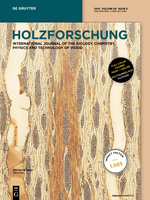
HOLZFORSCHUNG
Bridging theory and practice in wood applications.HOLZFORSCHUNG is a distinguished journal in the field of biomaterials, published by WALTER DE GRUYTER GMBH and based in Berlin, Germany. With an ISSN of 0018-3830 and an E-ISSN of 1437-434X, this journal has been a key player in advancing the understanding of wood research and its applications since its inception in 1947. As of 2023, it holds a Q3 ranking in the biomaterials category, positioned at #77 out of 137 in Scopus, reflecting its growing reputation within the academic community. Although it does not currently offer open access, HOLZFORSCHUNG aims to bridge the gap between theoretical research and practical applications, providing valuable insights for researchers, professionals, and students alike. With a focus on innovative studies and contributions to the understanding of wood as a biomaterial, it remains integral to the discourse in materials science.

JOURNAL OF WOOD SCIENCE
Connecting research with real-world applications in forestry.The JOURNAL OF WOOD SCIENCE, published by SPRINGER JAPAN KK, stands at the forefront of research in the field of wood science and forestry. With an ISSN of 1435-0211 and an E-ISSN of 1611-4663, this journal has been a vital resource since its inception in 1998, continuing to contribute valuable insights through 2024. As an Open Access publication since 2019, it ensures that groundbreaking research is accessible to a wide audience, fostering knowledge dissemination in the disciplines of Biomaterials and Forestry, where it holds prestigious rankings in Q3 and Q1 categories, respectively. Furthermore, it is recognized within Scopus, ranking #26 out of 174 in Agricultural and Biological Sciences - Forestry and #66 out of 137 in Materials Science - Biomaterials, reflecting its significant impact and relevancy in academic circles. Based in Tokyo, Japan, the journal aims to promote high-quality research that drives innovation and sustainability in wood-related disciplines, making it an essential read for researchers, industry professionals, and students alike.

COMPOSITES PART A-APPLIED SCIENCE AND MANUFACTURING
Exploring New Horizons in Composites ScienceCOMPOSITES PART A-APPLIED SCIENCE AND MANUFACTURING, published by Elsevier Science Ltd, is a premier international journal that serves as a vital platform for the dissemination of high-impact research and innovation in the fields of composite materials and manufacturing technologies. With an impact factor that reflects its outstanding reputation, this journal is categorized in the Q1 quartile for both Ceramics and Composites and Mechanics of Materials, positioning it among the top journals in these disciplines. It holds impressive ranks in Scopus, specifically Rank #16 out of 398 in Engineering - Mechanics of Materials and Rank #10 out of 127 in Materials Science - Ceramics and Composites, reinforcing its authoritative stance in the field. Spanning from 1996 to 2024, the journal features a wide array of research articles, reviews, and case studies that collectively enhance understanding and foster advancements in composite materials. With an open access model facilitating wide dissemination, COMPOSITES PART A is indispensable for researchers, professionals, and students striving to push the boundaries of materials science and engineering.
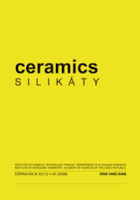
CERAMICS-SILIKATY
Advancing the Science of Ceramics and CompositesCERAMICS-SILIKATY is a distinguished open-access journal published by the University of Chemistry and Technology, Prague, specializing in the fields of Ceramics and Composites, Analytical Chemistry, Chemical Engineering, and Materials Chemistry. Since its inception in 1991, this journal has played a pivotal role in disseminating cutting-edge research and innovative findings in the study of ceramics, emphasizing both fundamental and applied aspects. With a commitment to accessibility since 2000, CERAMICS-SILIKATY promotes knowledge sharing among researchers, professionals, and students globally. The journal's current standing in the Q3 Quartile across several categories highlights its significant contributions and relevance in the academic community. As a hub for interdisciplinary research, the journal invites submissions that advanced our understanding of ceramic materials and their applications, positioning itself as an essential resource for those engaged in the forefront of materials science.

Maderas-Ciencia y Tecnologia
Innovating solutions for sustainable forestry and materials.Maderas-Ciencia y Tecnologia, published by UNIV BIO-BIO in Chile, is a prestigious open-access journal dedicated to advancing knowledge in the fields of Forestry, Chemical Engineering, and Materials Science. With an ISSN of 0717-3644 and an E-ISSN of 0718-221X, this journal has been serving the academic community since 2005, providing a platform for research that spans multiple disciplines including Industrial and Manufacturing Engineering. Recognized for its scholarly contributions, Maderas-Ciencia y Tecnologia achieves a commendable Q2 ranking in Forestry and several Q3 rankings in associated fields such as Chemical Engineering and Materials Science as of 2023. The journal aims to foster innovation and collaboration by publishing high-quality research articles that address pressing issues in wood engineering and technology, appealing to researchers, professionals, and students alike. With a strong commitment to open access, all content is readily available to a global audience, ensuring the widespread dissemination of knowledge and fostering advancements within these critical areas.

Drewno
Exploring the Intersection of Nature and EngineeringDrewno is an esteemed, peer-reviewed Open Access journal dedicated to advancing knowledge in the fields of Biomaterials, Forestry, and Industrial and Manufacturing Engineering. Published by the Institute of Wood Technology in Poland, the journal has been an invaluable resource for researchers and practitioners alike since its inception in 2009. With an impact factor reflected in its notable rankings—Q4 in Biomaterials, Q3 in both Forestry and Industrial and Manufacturing Engineering—it offers a unique platform for disseminating groundbreaking research and innovative practices.
As a fully Open Access journal since 2021, Drewno ensures that its content is freely accessible, promoting widespread dissemination of knowledge within the academic community and beyond. Situated at the crossroads of engineering and biological sciences, it serves as a critical conduit for collaborative research and development. Researchers, professionals, and students are encouraged to contribute and engage with the vital discussions shaping the future of material sciences and sustainable forest management.
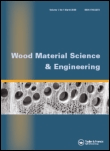
Wood Material Science & Engineering
Fostering Interdisciplinary Research in Wood EngineeringWood Material Science & Engineering, published by Taylor & Francis Ltd, is a pivotal journal in the field of materials science, focusing specifically on the intricate properties, performance, and applications of wood-based materials. With an ISSN of 1748-0272 and an E-ISSN of 1748-0280, this journal has established itself as a valuable resource for researchers and professionals working in the interdisciplinary domains of material science and engineering related to wood. Since its inception in 2006, the journal has seen continual growth, with its 2023 Scopus Rank placing it in the 49th percentile among general materials science journals. Although listed in Q3 of the materials science category, it plays a crucial role in facilitating innovative research and applications of wood materials, thereby significantly influencing sustainable practices in engineering and design. The journal invites original research articles, reviews, and case studies to further the understanding of wood materials, making it an ideal platform for scholars and practitioners dedicated to advancing material science. For researchers looking to disseminate their findings to a global audience, Wood Material Science & Engineering promises a dedicated avenue for impactful communication.